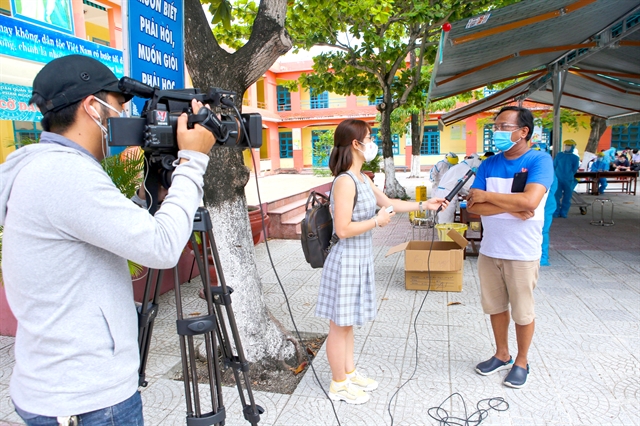 Society
Society

Working as a female reporter is hard at the best of times, but reporting from COVID-19 outbreak zones and risking infection is even tougher.

|
| A reporter of the Vietnam News Agency interviews a foreigner in Đà Nẵng about COVID-19 testing. — VNA/VNS Photo Lê Lâm |
HÀ NỘI — Working as a female reporter is hard at the best of times, but reporting from COVID-19 outbreak zones and risking infection is even tougher.
Hoàng Lan, a female reporter of Pháp Luật Thành Phố Hồ Chí Minh (HCM City’s Legal Affairs) newspaper, will never forget waking up at 4am on national election day (May 23) to cover the election in quarantine areas at Củ Chi Field Hospital in HCM City.
“I left home at 4.30 and arrived at the hospital at 6am. The ballot area was set up in the quarantine areas and treatment areas. Before the election started, everyone had their samples tested for COVID-19. Despite casting the ballots at the hospital, I saw that the constituents were very happy,” she said.
“I felt happy too because I could report on the atmosphere and patients’ feelings at a special voting venue,” she told the Vietnam News Agency.
Since the resurgence of COVID-19 in Việt Nam in April, health reporters like Nguyễn Thủy from Nông Nghiệp Việt Nam (Vietnamese Agriculture) newspaper, have had to work harder.
“The pressure has mounted. Health reporters have to access various sources of news to have the most accurate reports,” she said.
“My family’s daily routines have changed. If we want to access the latest news, we are ready to go to the epicentre. Sometimes we do that without letting our families know,” Thủy said.
“The healthcare knowledge that we [health correspondents] gain while interviewing doctors and medical experts helps us know how to protect ourselves. Reporters are among priority groups for vaccination so I am lucky to be among the correspondents who have received the shots. I feel safer while working in the field. In spite of that, I always remind myself to take preventive measures so I can ensure safety for my coverage and bring the latest news to readers.”
Hoài Thương, a female reporter of Sức Khỏe&Đời Sống (Health and Life) newspaper, headed to industrial parks in HCM City to cover COVID-19 testing when the city opened pandemic screening checkpoints on the night of May 14.
She moved from place to place to cover the testing and was the only female reporter out at midnight.
She got home at 2am and typed up her reporting, resulting in two long stories and one short news piece being published that morning.
Thương said seeing in her eyes the sacrifice of medical workers and frontline forces gave her mixed feelings.
“When I saw medical workers taking samples for testing in wet protective suits, a nearsighted doctor had his glasses and spit-shielding equipment blurred by sweat and heat,” she said.
Other forces worked around the clock. In a stuffy and hot suit, a medical worker at the checkpoint for the first time still smiled and said: "I am tired but it’s better than making people suffer," Thương recalled.
Thủy of Nông Nghiệp Việt Nam said readers are very concerned about the pandemic development so COVID-19 news coverage must be reliable, accurate and not cause panic. The news needs to not only update on infection cases but also highlight solutions taken by authorities so that readers can follow, she said.
Lan of the HCM City’s Legal Affairs newspaper said despite the pressure to produce quick news, reporters still need to ensure accuracy to help the country fight the pandemic.
When HCM City’s Hospital for Tropical Diseases reported its first COVID-19 cases, a rumour was spread among healthcare reporters that there were a lot of infection cases at that time, including members of the intensive care unit, instead of only one.
However, the reporters waited for official confirmation and did not release the information. Then an official source said there were only three infected staff in the administrative unit, not the treatment unit, Lan said.
The lesson is that if reporters want to grab the latest information without ensuring its accuracy, it will cause public confusion. Reporters and news agencies will be punished for giving false information, she said. — VNS




